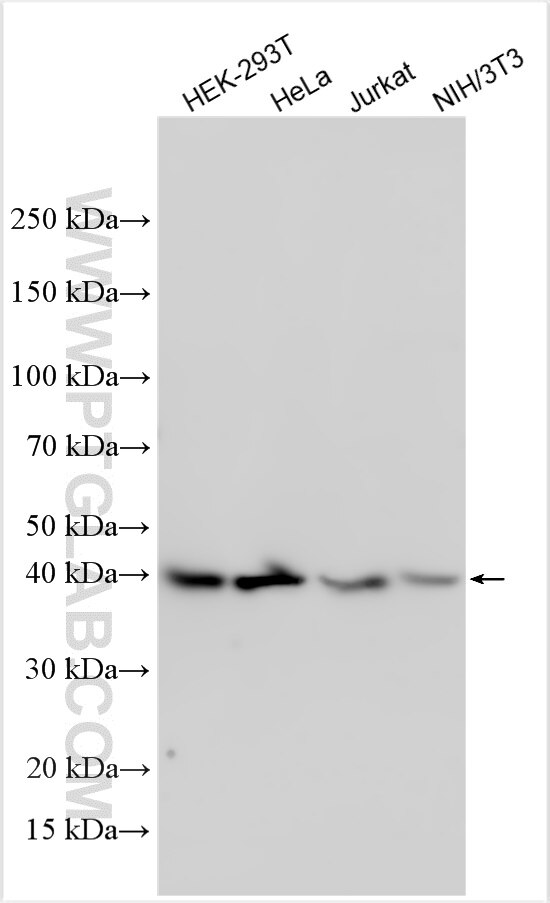Tested Applications
| Positive WB detected in | HEK-293T cells, HeLa cells, Jurkat cells, NIH/3T3 cells |
Recommended dilution
| Application | Dilution |
|---|---|
| Western Blot (WB) | WB : 1:1000-1:4000 |
| It is recommended that this reagent should be titrated in each testing system to obtain optimal results. | |
| Sample-dependent, Check data in validation data gallery. | |
Product Information
32161-1-AP targets UBFD1 in WB, ELISA applications and shows reactivity with human, mouse samples.
| Tested Reactivity | human, mouse |
| Host / Isotype | Rabbit / IgG |
| Class | Polyclonal |
| Type | Antibody |
| Immunogen | UBFD1 fusion protein Ag36361 Predict reactive species |
| Full Name | ubiquitin family domain containing 1 |
| Calculated Molecular Weight | 309aa, 33 kDa |
| Observed Molecular Weight | 40 kDa |
| GenBank Accession Number | NM_019116 |
| Gene Symbol | UBFD1 |
| Gene ID (NCBI) | 56061 |
| Conjugate | Unconjugated |
| Form | Liquid |
| Purification Method | Antigen affinity Purification |
| UNIPROT ID | O14562 |
| Storage Buffer | PBS with 0.02% sodium azide and 50% glycerol, pH 7.3. |
| Storage Conditions | Store at -20°C. Stable for one year after shipment. Aliquoting is unnecessary for -20oC storage. 20ul sizes contain 0.1% BSA. |
Background Information
UBFD1 (Ubiquitin Family Domain Containing 1) is a polyubiquitin-binding protein containing ubiquitin-like structural domains that are widely involved in protein degradation and cell signaling. This protein shows aberrant expression in a variety of cancers, especially in estrogen receptor (ER)-positive breast cancer, where high expression of UBFD1 is closely associated with poor prognosis of patients, and is considered as a potential prognostic biomarker and therapeutic target. In addition, UBFD1 was also found to be associated with MYC-mediated tumor aggressiveness in T-cell acute lymphoblastic leukemia (T-ALL), which functionally involves the endoplasmic reticulum-associated degradation (ERAD) pathway. UBFD1 is also expressed in inner ear hair cells and ear epithelial cells, suggesting that it may play a role in hearing-related diseases.
Protocols
| Product Specific Protocols | |
|---|---|
| WB protocol for UBFD1 antibody 32161-1-AP | Download protocol |
| Standard Protocols | |
|---|---|
| Click here to view our Standard Protocols |



